Ethical Considerations in Nursing Practice
VerifiedAdded on 2020/03/16
|11
|3028
|495
AI Summary
This assignment delves into the complex world of ethical considerations within nursing practice. It examines various ethical principles guiding nursing actions, such as autonomy, beneficence, non-maleficence, and justice. Students are tasked with analyzing real-world scenarios involving ethical dilemmas in healthcare, considering the impact of these issues on patient well-being and professional responsibilities. The assignment encourages critical thinking and the application of ethical frameworks to develop solutions for navigating challenging situations encountered by nurses.
Contribute Materials
Your contribution can guide someone’s learning journey. Share your
documents today.
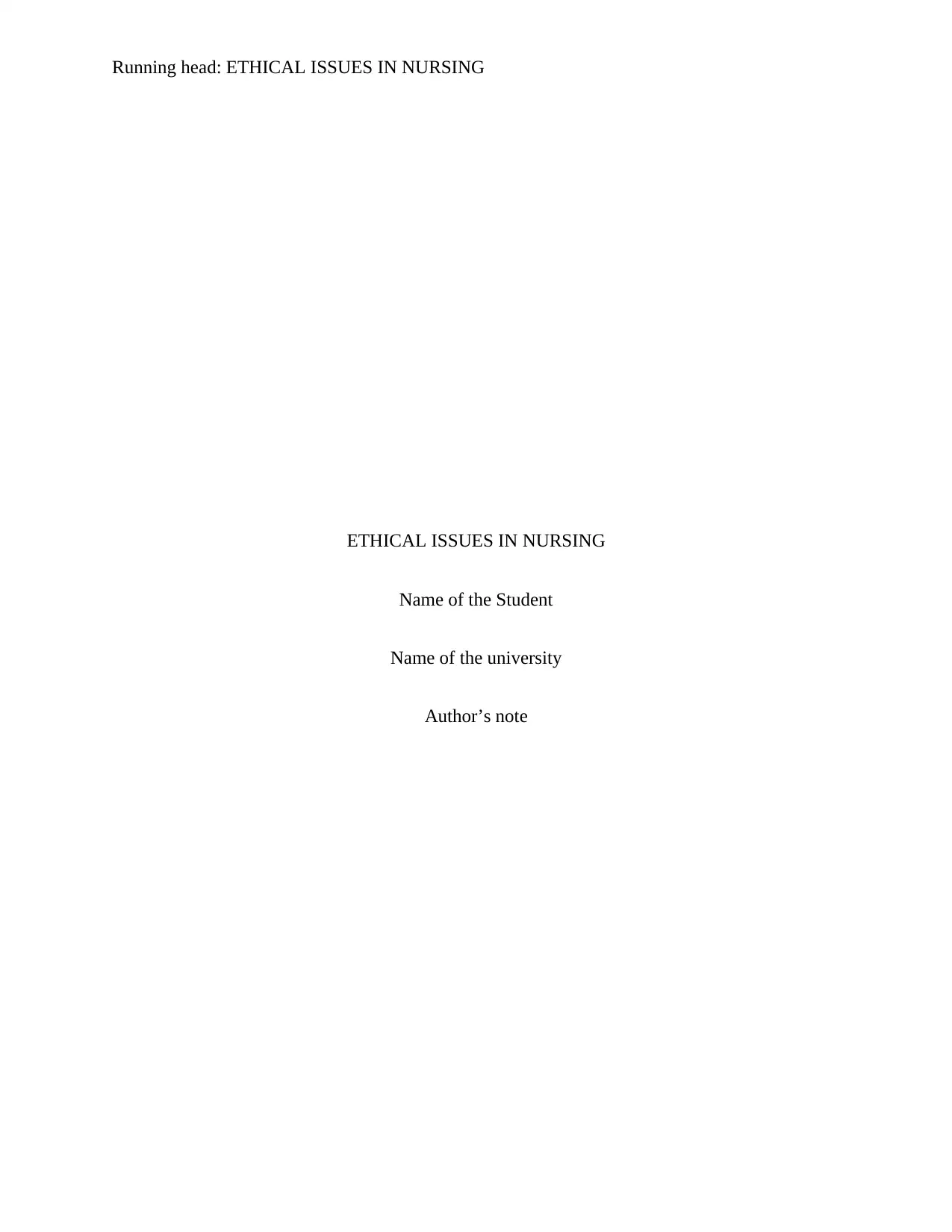
Running head: ETHICAL ISSUES IN NURSING
ETHICAL ISSUES IN NURSING
Name of the Student
Name of the university
Author’s note
ETHICAL ISSUES IN NURSING
Name of the Student
Name of the university
Author’s note
Secure Best Marks with AI Grader
Need help grading? Try our AI Grader for instant feedback on your assignments.
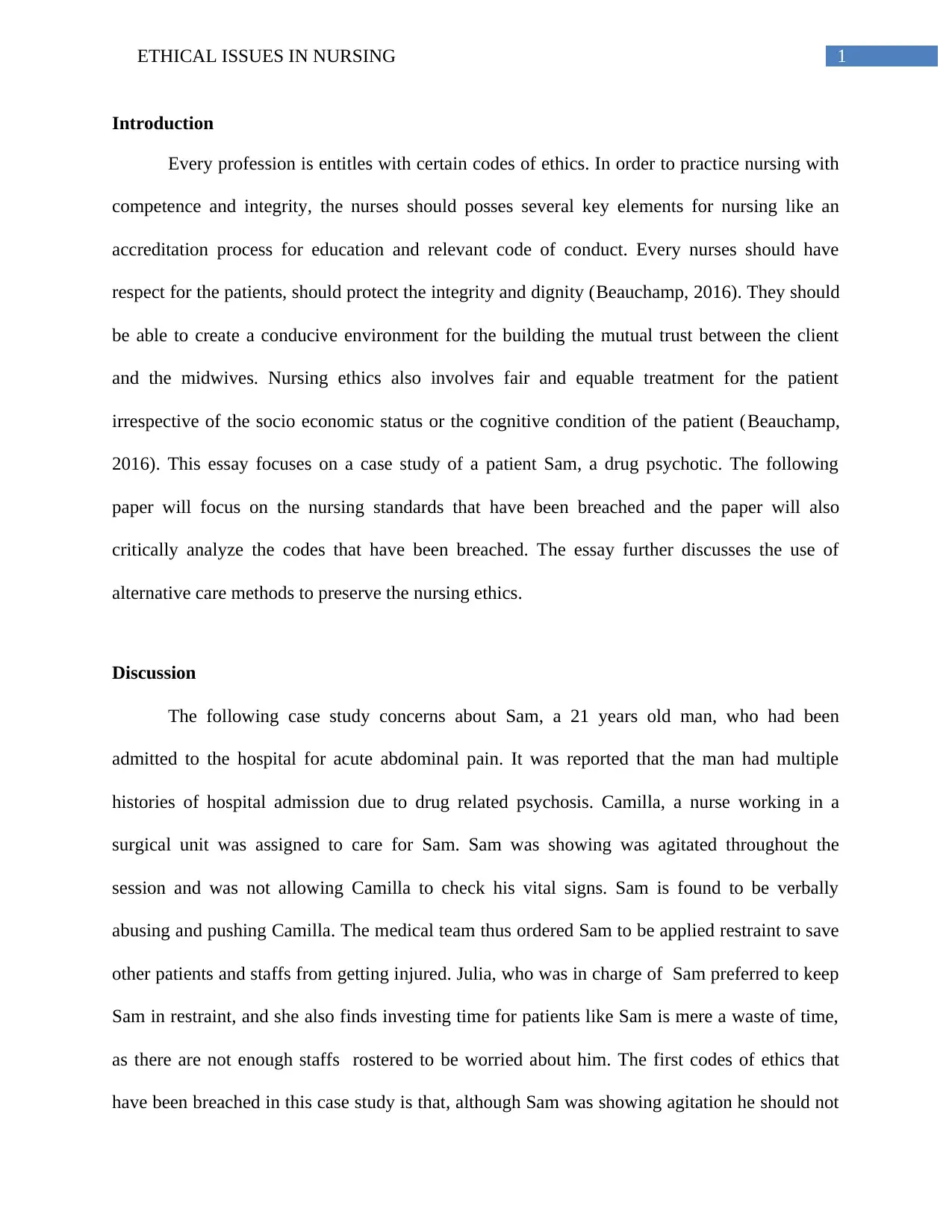
1ETHICAL ISSUES IN NURSING
Introduction
Every profession is entitles with certain codes of ethics. In order to practice nursing with
competence and integrity, the nurses should posses several key elements for nursing like an
accreditation process for education and relevant code of conduct. Every nurses should have
respect for the patients, should protect the integrity and dignity (Beauchamp, 2016). They should
be able to create a conducive environment for the building the mutual trust between the client
and the midwives. Nursing ethics also involves fair and equable treatment for the patient
irrespective of the socio economic status or the cognitive condition of the patient (Beauchamp,
2016). This essay focuses on a case study of a patient Sam, a drug psychotic. The following
paper will focus on the nursing standards that have been breached and the paper will also
critically analyze the codes that have been breached. The essay further discusses the use of
alternative care methods to preserve the nursing ethics.
Discussion
The following case study concerns about Sam, a 21 years old man, who had been
admitted to the hospital for acute abdominal pain. It was reported that the man had multiple
histories of hospital admission due to drug related psychosis. Camilla, a nurse working in a
surgical unit was assigned to care for Sam. Sam was showing was agitated throughout the
session and was not allowing Camilla to check his vital signs. Sam is found to be verbally
abusing and pushing Camilla. The medical team thus ordered Sam to be applied restraint to save
other patients and staffs from getting injured. Julia, who was in charge of Sam preferred to keep
Sam in restraint, and she also finds investing time for patients like Sam is mere a waste of time,
as there are not enough staffs rostered to be worried about him. The first codes of ethics that
have been breached in this case study is that, although Sam was showing agitation he should not
Introduction
Every profession is entitles with certain codes of ethics. In order to practice nursing with
competence and integrity, the nurses should posses several key elements for nursing like an
accreditation process for education and relevant code of conduct. Every nurses should have
respect for the patients, should protect the integrity and dignity (Beauchamp, 2016). They should
be able to create a conducive environment for the building the mutual trust between the client
and the midwives. Nursing ethics also involves fair and equable treatment for the patient
irrespective of the socio economic status or the cognitive condition of the patient (Beauchamp,
2016). This essay focuses on a case study of a patient Sam, a drug psychotic. The following
paper will focus on the nursing standards that have been breached and the paper will also
critically analyze the codes that have been breached. The essay further discusses the use of
alternative care methods to preserve the nursing ethics.
Discussion
The following case study concerns about Sam, a 21 years old man, who had been
admitted to the hospital for acute abdominal pain. It was reported that the man had multiple
histories of hospital admission due to drug related psychosis. Camilla, a nurse working in a
surgical unit was assigned to care for Sam. Sam was showing was agitated throughout the
session and was not allowing Camilla to check his vital signs. Sam is found to be verbally
abusing and pushing Camilla. The medical team thus ordered Sam to be applied restraint to save
other patients and staffs from getting injured. Julia, who was in charge of Sam preferred to keep
Sam in restraint, and she also finds investing time for patients like Sam is mere a waste of time,
as there are not enough staffs rostered to be worried about him. The first codes of ethics that
have been breached in this case study is that, although Sam was showing agitation he should not
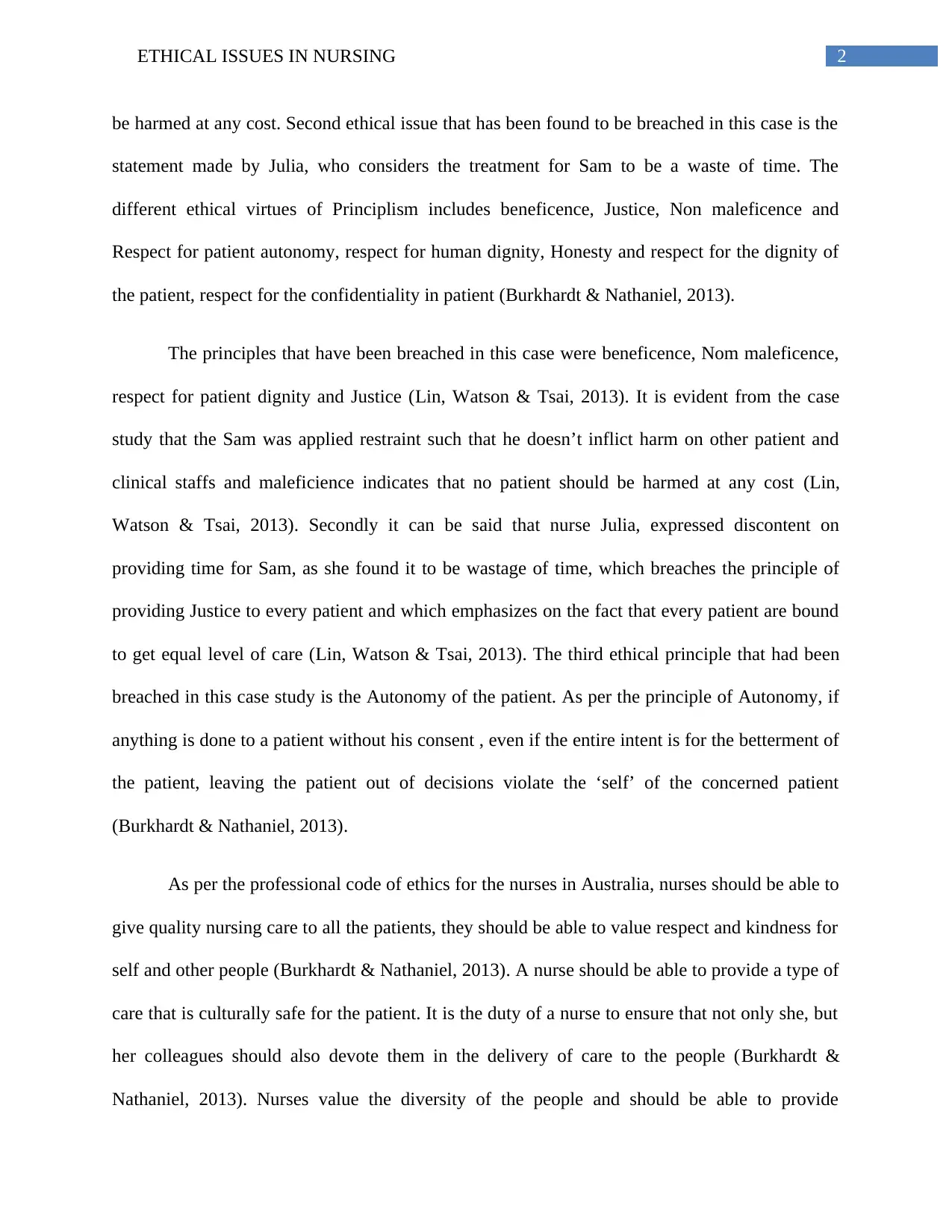
2ETHICAL ISSUES IN NURSING
be harmed at any cost. Second ethical issue that has been found to be breached in this case is the
statement made by Julia, who considers the treatment for Sam to be a waste of time. The
different ethical virtues of Principlism includes beneficence, Justice, Non maleficence and
Respect for patient autonomy, respect for human dignity, Honesty and respect for the dignity of
the patient, respect for the confidentiality in patient (Burkhardt & Nathaniel, 2013).
The principles that have been breached in this case were beneficence, Nom maleficence,
respect for patient dignity and Justice (Lin, Watson & Tsai, 2013). It is evident from the case
study that the Sam was applied restraint such that he doesn’t inflict harm on other patient and
clinical staffs and maleficience indicates that no patient should be harmed at any cost (Lin,
Watson & Tsai, 2013). Secondly it can be said that nurse Julia, expressed discontent on
providing time for Sam, as she found it to be wastage of time, which breaches the principle of
providing Justice to every patient and which emphasizes on the fact that every patient are bound
to get equal level of care (Lin, Watson & Tsai, 2013). The third ethical principle that had been
breached in this case study is the Autonomy of the patient. As per the principle of Autonomy, if
anything is done to a patient without his consent , even if the entire intent is for the betterment of
the patient, leaving the patient out of decisions violate the ‘self’ of the concerned patient
(Burkhardt & Nathaniel, 2013).
As per the professional code of ethics for the nurses in Australia, nurses should be able to
give quality nursing care to all the patients, they should be able to value respect and kindness for
self and other people (Burkhardt & Nathaniel, 2013). A nurse should be able to provide a type of
care that is culturally safe for the patient. It is the duty of a nurse to ensure that not only she, but
her colleagues should also devote them in the delivery of care to the people (Burkhardt &
Nathaniel, 2013). Nurses value the diversity of the people and should be able to provide
be harmed at any cost. Second ethical issue that has been found to be breached in this case is the
statement made by Julia, who considers the treatment for Sam to be a waste of time. The
different ethical virtues of Principlism includes beneficence, Justice, Non maleficence and
Respect for patient autonomy, respect for human dignity, Honesty and respect for the dignity of
the patient, respect for the confidentiality in patient (Burkhardt & Nathaniel, 2013).
The principles that have been breached in this case were beneficence, Nom maleficence,
respect for patient dignity and Justice (Lin, Watson & Tsai, 2013). It is evident from the case
study that the Sam was applied restraint such that he doesn’t inflict harm on other patient and
clinical staffs and maleficience indicates that no patient should be harmed at any cost (Lin,
Watson & Tsai, 2013). Secondly it can be said that nurse Julia, expressed discontent on
providing time for Sam, as she found it to be wastage of time, which breaches the principle of
providing Justice to every patient and which emphasizes on the fact that every patient are bound
to get equal level of care (Lin, Watson & Tsai, 2013). The third ethical principle that had been
breached in this case study is the Autonomy of the patient. As per the principle of Autonomy, if
anything is done to a patient without his consent , even if the entire intent is for the betterment of
the patient, leaving the patient out of decisions violate the ‘self’ of the concerned patient
(Burkhardt & Nathaniel, 2013).
As per the professional code of ethics for the nurses in Australia, nurses should be able to
give quality nursing care to all the patients, they should be able to value respect and kindness for
self and other people (Burkhardt & Nathaniel, 2013). A nurse should be able to provide a type of
care that is culturally safe for the patient. It is the duty of a nurse to ensure that not only she, but
her colleagues should also devote them in the delivery of care to the people (Burkhardt &
Nathaniel, 2013). Nurses value the diversity of the people and should be able to provide
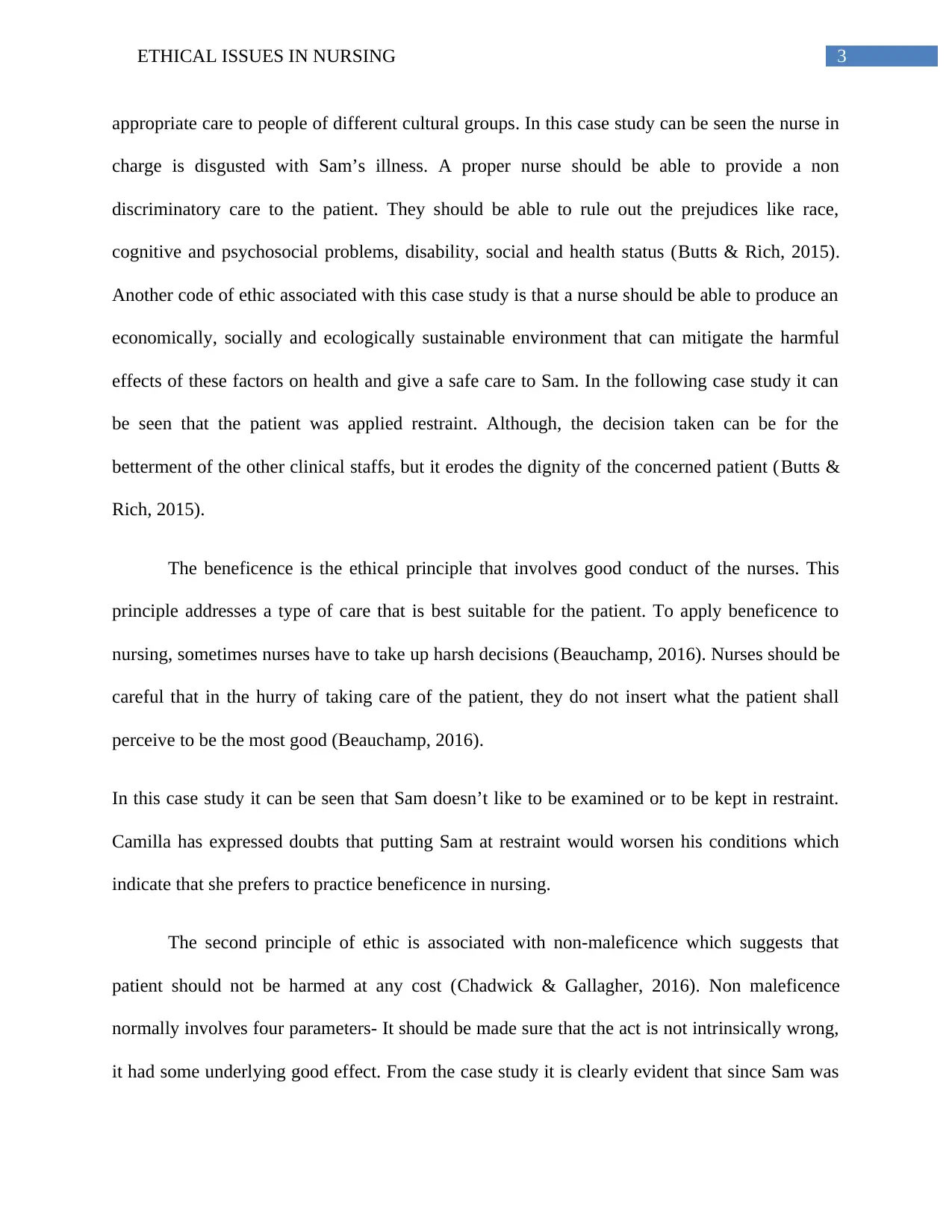
3ETHICAL ISSUES IN NURSING
appropriate care to people of different cultural groups. In this case study can be seen the nurse in
charge is disgusted with Sam’s illness. A proper nurse should be able to provide a non
discriminatory care to the patient. They should be able to rule out the prejudices like race,
cognitive and psychosocial problems, disability, social and health status (Butts & Rich, 2015).
Another code of ethic associated with this case study is that a nurse should be able to produce an
economically, socially and ecologically sustainable environment that can mitigate the harmful
effects of these factors on health and give a safe care to Sam. In the following case study it can
be seen that the patient was applied restraint. Although, the decision taken can be for the
betterment of the other clinical staffs, but it erodes the dignity of the concerned patient (Butts &
Rich, 2015).
The beneficence is the ethical principle that involves good conduct of the nurses. This
principle addresses a type of care that is best suitable for the patient. To apply beneficence to
nursing, sometimes nurses have to take up harsh decisions (Beauchamp, 2016). Nurses should be
careful that in the hurry of taking care of the patient, they do not insert what the patient shall
perceive to be the most good (Beauchamp, 2016).
In this case study it can be seen that Sam doesn’t like to be examined or to be kept in restraint.
Camilla has expressed doubts that putting Sam at restraint would worsen his conditions which
indicate that she prefers to practice beneficence in nursing.
The second principle of ethic is associated with non-maleficence which suggests that
patient should not be harmed at any cost (Chadwick & Gallagher, 2016). Non maleficence
normally involves four parameters- It should be made sure that the act is not intrinsically wrong,
it had some underlying good effect. From the case study it is clearly evident that since Sam was
appropriate care to people of different cultural groups. In this case study can be seen the nurse in
charge is disgusted with Sam’s illness. A proper nurse should be able to provide a non
discriminatory care to the patient. They should be able to rule out the prejudices like race,
cognitive and psychosocial problems, disability, social and health status (Butts & Rich, 2015).
Another code of ethic associated with this case study is that a nurse should be able to produce an
economically, socially and ecologically sustainable environment that can mitigate the harmful
effects of these factors on health and give a safe care to Sam. In the following case study it can
be seen that the patient was applied restraint. Although, the decision taken can be for the
betterment of the other clinical staffs, but it erodes the dignity of the concerned patient (Butts &
Rich, 2015).
The beneficence is the ethical principle that involves good conduct of the nurses. This
principle addresses a type of care that is best suitable for the patient. To apply beneficence to
nursing, sometimes nurses have to take up harsh decisions (Beauchamp, 2016). Nurses should be
careful that in the hurry of taking care of the patient, they do not insert what the patient shall
perceive to be the most good (Beauchamp, 2016).
In this case study it can be seen that Sam doesn’t like to be examined or to be kept in restraint.
Camilla has expressed doubts that putting Sam at restraint would worsen his conditions which
indicate that she prefers to practice beneficence in nursing.
The second principle of ethic is associated with non-maleficence which suggests that
patient should not be harmed at any cost (Chadwick & Gallagher, 2016). Non maleficence
normally involves four parameters- It should be made sure that the act is not intrinsically wrong,
it had some underlying good effect. From the case study it is clearly evident that since Sam was
Secure Best Marks with AI Grader
Need help grading? Try our AI Grader for instant feedback on your assignments.
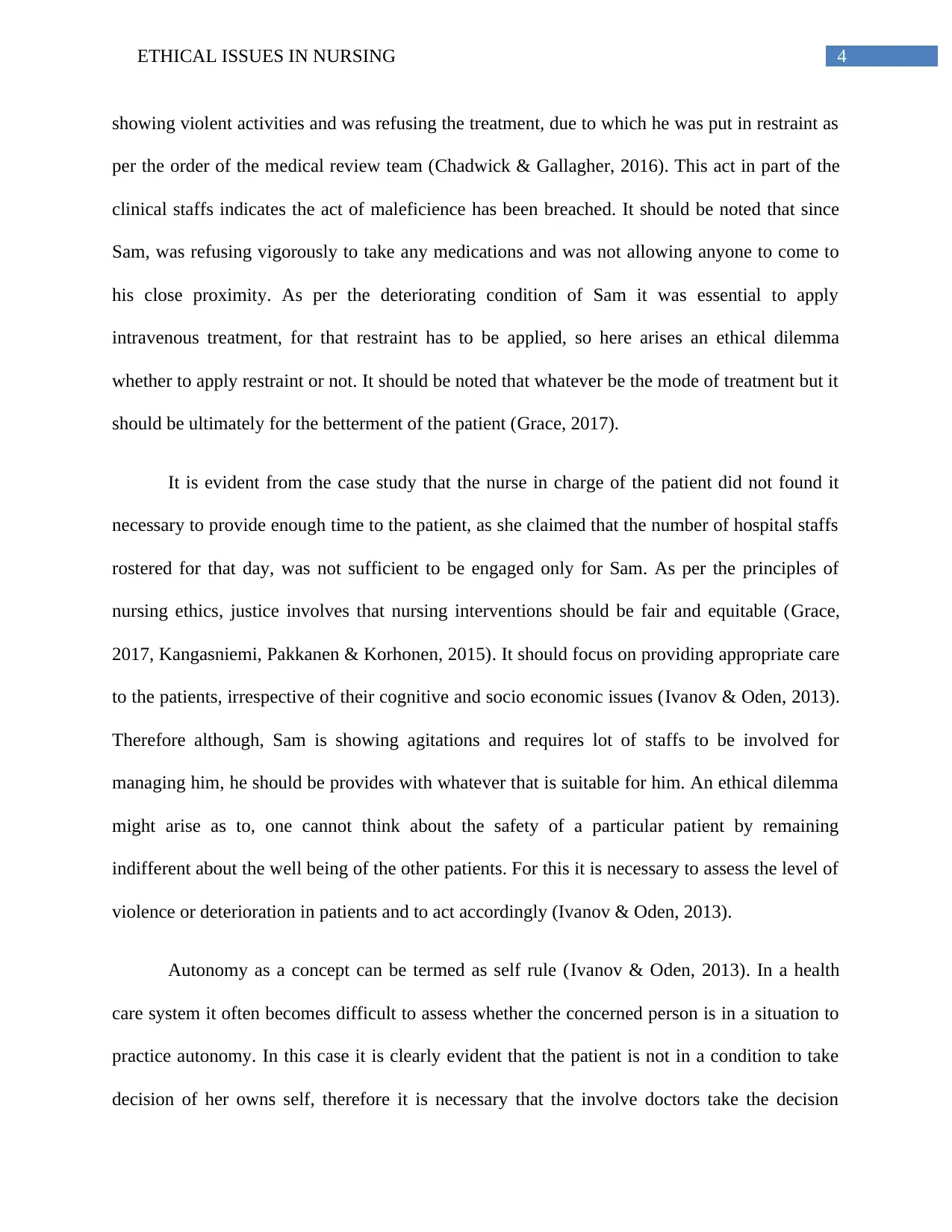
4ETHICAL ISSUES IN NURSING
showing violent activities and was refusing the treatment, due to which he was put in restraint as
per the order of the medical review team (Chadwick & Gallagher, 2016). This act in part of the
clinical staffs indicates the act of maleficience has been breached. It should be noted that since
Sam, was refusing vigorously to take any medications and was not allowing anyone to come to
his close proximity. As per the deteriorating condition of Sam it was essential to apply
intravenous treatment, for that restraint has to be applied, so here arises an ethical dilemma
whether to apply restraint or not. It should be noted that whatever be the mode of treatment but it
should be ultimately for the betterment of the patient (Grace, 2017).
It is evident from the case study that the nurse in charge of the patient did not found it
necessary to provide enough time to the patient, as she claimed that the number of hospital staffs
rostered for that day, was not sufficient to be engaged only for Sam. As per the principles of
nursing ethics, justice involves that nursing interventions should be fair and equitable (Grace,
2017, Kangasniemi, Pakkanen & Korhonen, 2015). It should focus on providing appropriate care
to the patients, irrespective of their cognitive and socio economic issues (Ivanov & Oden, 2013).
Therefore although, Sam is showing agitations and requires lot of staffs to be involved for
managing him, he should be provides with whatever that is suitable for him. An ethical dilemma
might arise as to, one cannot think about the safety of a particular patient by remaining
indifferent about the well being of the other patients. For this it is necessary to assess the level of
violence or deterioration in patients and to act accordingly (Ivanov & Oden, 2013).
Autonomy as a concept can be termed as self rule (Ivanov & Oden, 2013). In a health
care system it often becomes difficult to assess whether the concerned person is in a situation to
practice autonomy. In this case it is clearly evident that the patient is not in a condition to take
decision of her owns self, therefore it is necessary that the involve doctors take the decision
showing violent activities and was refusing the treatment, due to which he was put in restraint as
per the order of the medical review team (Chadwick & Gallagher, 2016). This act in part of the
clinical staffs indicates the act of maleficience has been breached. It should be noted that since
Sam, was refusing vigorously to take any medications and was not allowing anyone to come to
his close proximity. As per the deteriorating condition of Sam it was essential to apply
intravenous treatment, for that restraint has to be applied, so here arises an ethical dilemma
whether to apply restraint or not. It should be noted that whatever be the mode of treatment but it
should be ultimately for the betterment of the patient (Grace, 2017).
It is evident from the case study that the nurse in charge of the patient did not found it
necessary to provide enough time to the patient, as she claimed that the number of hospital staffs
rostered for that day, was not sufficient to be engaged only for Sam. As per the principles of
nursing ethics, justice involves that nursing interventions should be fair and equitable (Grace,
2017, Kangasniemi, Pakkanen & Korhonen, 2015). It should focus on providing appropriate care
to the patients, irrespective of their cognitive and socio economic issues (Ivanov & Oden, 2013).
Therefore although, Sam is showing agitations and requires lot of staffs to be involved for
managing him, he should be provides with whatever that is suitable for him. An ethical dilemma
might arise as to, one cannot think about the safety of a particular patient by remaining
indifferent about the well being of the other patients. For this it is necessary to assess the level of
violence or deterioration in patients and to act accordingly (Ivanov & Oden, 2013).
Autonomy as a concept can be termed as self rule (Ivanov & Oden, 2013). In a health
care system it often becomes difficult to assess whether the concerned person is in a situation to
practice autonomy. In this case it is clearly evident that the patient is not in a condition to take
decision of her owns self, therefore it is necessary that the involve doctors take the decision
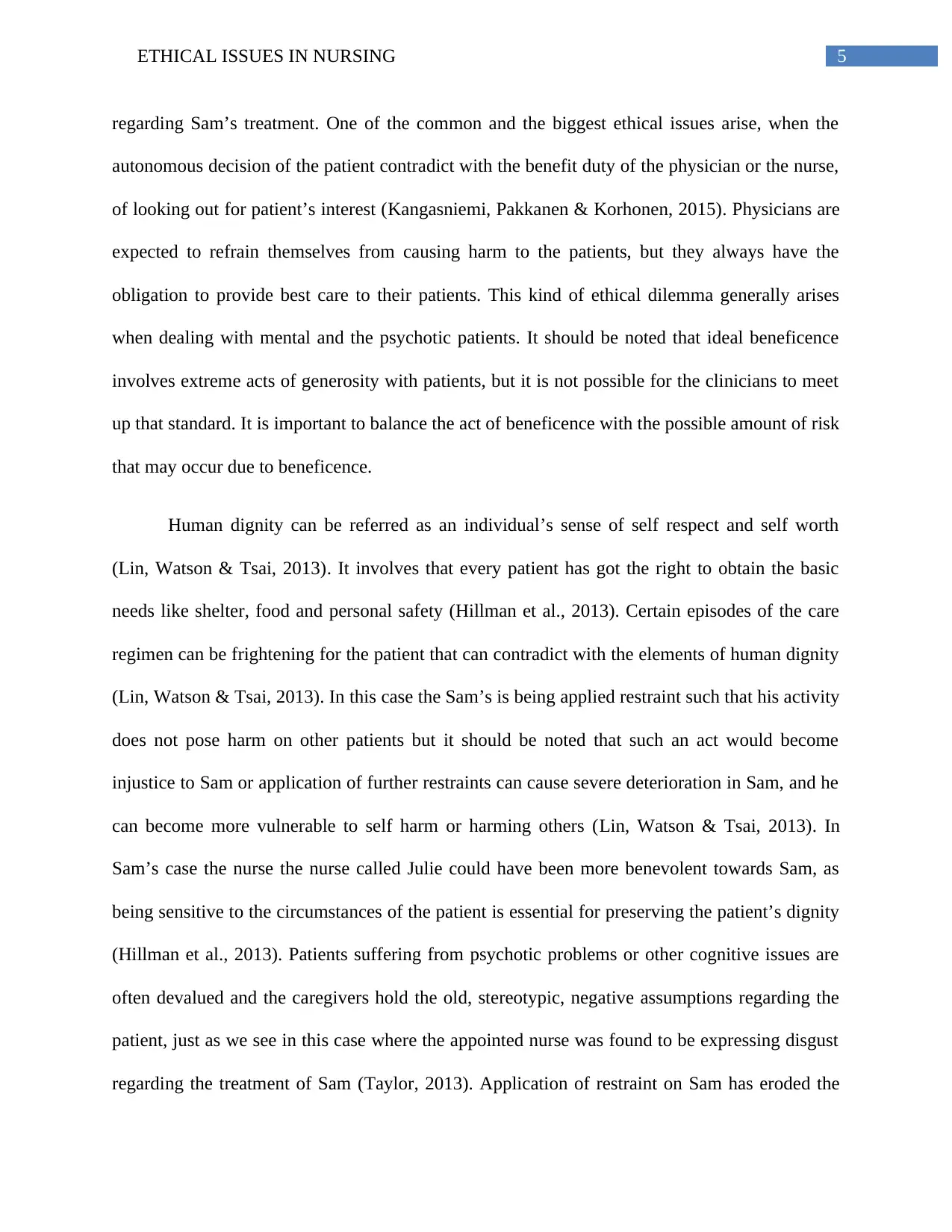
5ETHICAL ISSUES IN NURSING
regarding Sam’s treatment. One of the common and the biggest ethical issues arise, when the
autonomous decision of the patient contradict with the benefit duty of the physician or the nurse,
of looking out for patient’s interest (Kangasniemi, Pakkanen & Korhonen, 2015). Physicians are
expected to refrain themselves from causing harm to the patients, but they always have the
obligation to provide best care to their patients. This kind of ethical dilemma generally arises
when dealing with mental and the psychotic patients. It should be noted that ideal beneficence
involves extreme acts of generosity with patients, but it is not possible for the clinicians to meet
up that standard. It is important to balance the act of beneficence with the possible amount of risk
that may occur due to beneficence.
Human dignity can be referred as an individual’s sense of self respect and self worth
(Lin, Watson & Tsai, 2013). It involves that every patient has got the right to obtain the basic
needs like shelter, food and personal safety (Hillman et al., 2013). Certain episodes of the care
regimen can be frightening for the patient that can contradict with the elements of human dignity
(Lin, Watson & Tsai, 2013). In this case the Sam’s is being applied restraint such that his activity
does not pose harm on other patients but it should be noted that such an act would become
injustice to Sam or application of further restraints can cause severe deterioration in Sam, and he
can become more vulnerable to self harm or harming others (Lin, Watson & Tsai, 2013). In
Sam’s case the nurse the nurse called Julie could have been more benevolent towards Sam, as
being sensitive to the circumstances of the patient is essential for preserving the patient’s dignity
(Hillman et al., 2013). Patients suffering from psychotic problems or other cognitive issues are
often devalued and the caregivers hold the old, stereotypic, negative assumptions regarding the
patient, just as we see in this case where the appointed nurse was found to be expressing disgust
regarding the treatment of Sam (Taylor, 2013). Application of restraint on Sam has eroded the
regarding Sam’s treatment. One of the common and the biggest ethical issues arise, when the
autonomous decision of the patient contradict with the benefit duty of the physician or the nurse,
of looking out for patient’s interest (Kangasniemi, Pakkanen & Korhonen, 2015). Physicians are
expected to refrain themselves from causing harm to the patients, but they always have the
obligation to provide best care to their patients. This kind of ethical dilemma generally arises
when dealing with mental and the psychotic patients. It should be noted that ideal beneficence
involves extreme acts of generosity with patients, but it is not possible for the clinicians to meet
up that standard. It is important to balance the act of beneficence with the possible amount of risk
that may occur due to beneficence.
Human dignity can be referred as an individual’s sense of self respect and self worth
(Lin, Watson & Tsai, 2013). It involves that every patient has got the right to obtain the basic
needs like shelter, food and personal safety (Hillman et al., 2013). Certain episodes of the care
regimen can be frightening for the patient that can contradict with the elements of human dignity
(Lin, Watson & Tsai, 2013). In this case the Sam’s is being applied restraint such that his activity
does not pose harm on other patients but it should be noted that such an act would become
injustice to Sam or application of further restraints can cause severe deterioration in Sam, and he
can become more vulnerable to self harm or harming others (Lin, Watson & Tsai, 2013). In
Sam’s case the nurse the nurse called Julie could have been more benevolent towards Sam, as
being sensitive to the circumstances of the patient is essential for preserving the patient’s dignity
(Hillman et al., 2013). Patients suffering from psychotic problems or other cognitive issues are
often devalued and the caregivers hold the old, stereotypic, negative assumptions regarding the
patient, just as we see in this case where the appointed nurse was found to be expressing disgust
regarding the treatment of Sam (Taylor, 2013). Application of restraint on Sam has eroded the
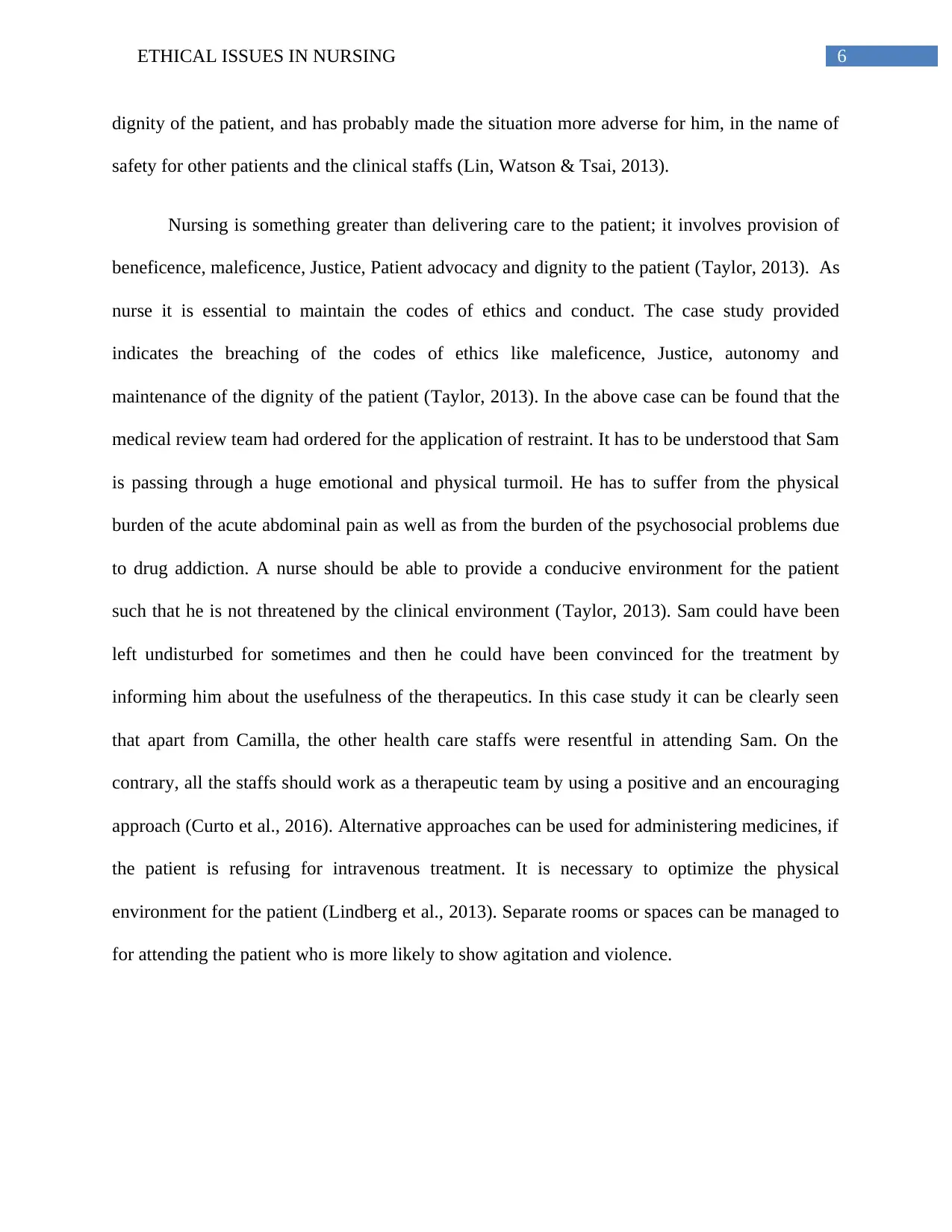
6ETHICAL ISSUES IN NURSING
dignity of the patient, and has probably made the situation more adverse for him, in the name of
safety for other patients and the clinical staffs (Lin, Watson & Tsai, 2013).
Nursing is something greater than delivering care to the patient; it involves provision of
beneficence, maleficence, Justice, Patient advocacy and dignity to the patient (Taylor, 2013). As
nurse it is essential to maintain the codes of ethics and conduct. The case study provided
indicates the breaching of the codes of ethics like maleficence, Justice, autonomy and
maintenance of the dignity of the patient (Taylor, 2013). In the above case can be found that the
medical review team had ordered for the application of restraint. It has to be understood that Sam
is passing through a huge emotional and physical turmoil. He has to suffer from the physical
burden of the acute abdominal pain as well as from the burden of the psychosocial problems due
to drug addiction. A nurse should be able to provide a conducive environment for the patient
such that he is not threatened by the clinical environment (Taylor, 2013). Sam could have been
left undisturbed for sometimes and then he could have been convinced for the treatment by
informing him about the usefulness of the therapeutics. In this case study it can be clearly seen
that apart from Camilla, the other health care staffs were resentful in attending Sam. On the
contrary, all the staffs should work as a therapeutic team by using a positive and an encouraging
approach (Curto et al., 2016). Alternative approaches can be used for administering medicines, if
the patient is refusing for intravenous treatment. It is necessary to optimize the physical
environment for the patient (Lindberg et al., 2013). Separate rooms or spaces can be managed to
for attending the patient who is more likely to show agitation and violence.
dignity of the patient, and has probably made the situation more adverse for him, in the name of
safety for other patients and the clinical staffs (Lin, Watson & Tsai, 2013).
Nursing is something greater than delivering care to the patient; it involves provision of
beneficence, maleficence, Justice, Patient advocacy and dignity to the patient (Taylor, 2013). As
nurse it is essential to maintain the codes of ethics and conduct. The case study provided
indicates the breaching of the codes of ethics like maleficence, Justice, autonomy and
maintenance of the dignity of the patient (Taylor, 2013). In the above case can be found that the
medical review team had ordered for the application of restraint. It has to be understood that Sam
is passing through a huge emotional and physical turmoil. He has to suffer from the physical
burden of the acute abdominal pain as well as from the burden of the psychosocial problems due
to drug addiction. A nurse should be able to provide a conducive environment for the patient
such that he is not threatened by the clinical environment (Taylor, 2013). Sam could have been
left undisturbed for sometimes and then he could have been convinced for the treatment by
informing him about the usefulness of the therapeutics. In this case study it can be clearly seen
that apart from Camilla, the other health care staffs were resentful in attending Sam. On the
contrary, all the staffs should work as a therapeutic team by using a positive and an encouraging
approach (Curto et al., 2016). Alternative approaches can be used for administering medicines, if
the patient is refusing for intravenous treatment. It is necessary to optimize the physical
environment for the patient (Lindberg et al., 2013). Separate rooms or spaces can be managed to
for attending the patient who is more likely to show agitation and violence.
Paraphrase This Document
Need a fresh take? Get an instant paraphrase of this document with our AI Paraphraser
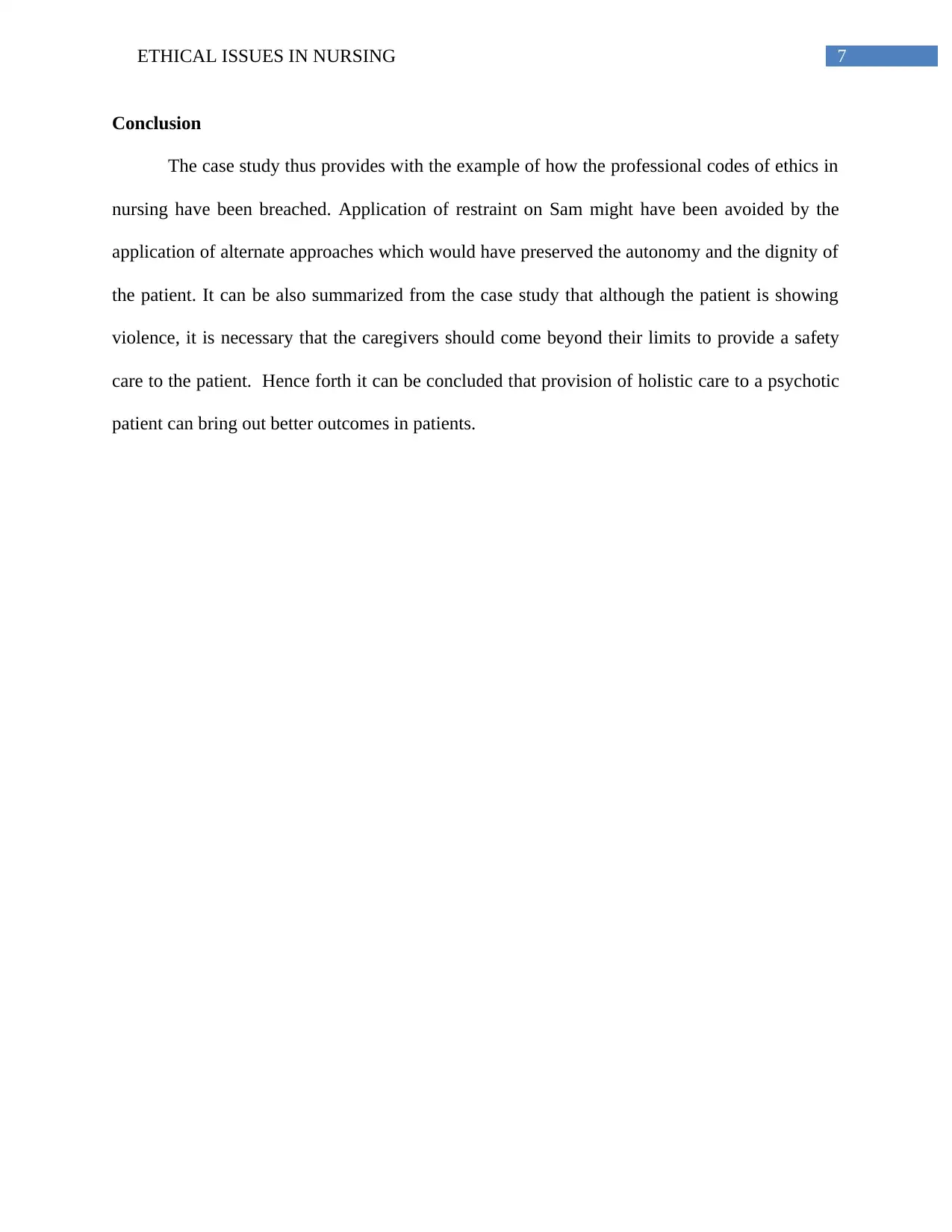
7ETHICAL ISSUES IN NURSING
Conclusion
The case study thus provides with the example of how the professional codes of ethics in
nursing have been breached. Application of restraint on Sam might have been avoided by the
application of alternate approaches which would have preserved the autonomy and the dignity of
the patient. It can be also summarized from the case study that although the patient is showing
violence, it is necessary that the caregivers should come beyond their limits to provide a safety
care to the patient. Hence forth it can be concluded that provision of holistic care to a psychotic
patient can bring out better outcomes in patients.
Conclusion
The case study thus provides with the example of how the professional codes of ethics in
nursing have been breached. Application of restraint on Sam might have been avoided by the
application of alternate approaches which would have preserved the autonomy and the dignity of
the patient. It can be also summarized from the case study that although the patient is showing
violence, it is necessary that the caregivers should come beyond their limits to provide a safety
care to the patient. Hence forth it can be concluded that provision of holistic care to a psychotic
patient can bring out better outcomes in patients.
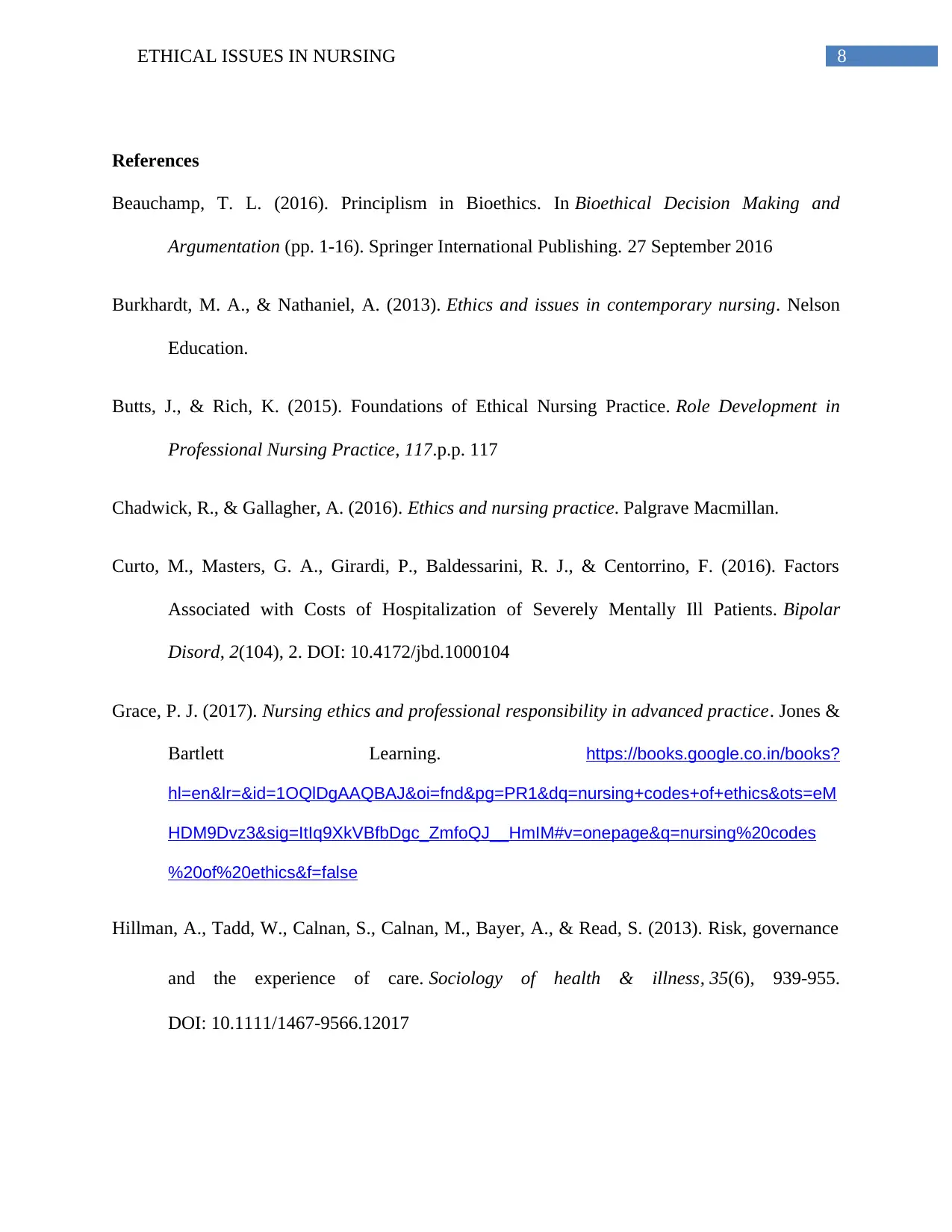
8ETHICAL ISSUES IN NURSING
References
Beauchamp, T. L. (2016). Principlism in Bioethics. In Bioethical Decision Making and
Argumentation (pp. 1-16). Springer International Publishing. 27 September 2016
Burkhardt, M. A., & Nathaniel, A. (2013). Ethics and issues in contemporary nursing. Nelson
Education.
Butts, J., & Rich, K. (2015). Foundations of Ethical Nursing Practice. Role Development in
Professional Nursing Practice, 117.p.p. 117
Chadwick, R., & Gallagher, A. (2016). Ethics and nursing practice. Palgrave Macmillan.
Curto, M., Masters, G. A., Girardi, P., Baldessarini, R. J., & Centorrino, F. (2016). Factors
Associated with Costs of Hospitalization of Severely Mentally Ill Patients. Bipolar
Disord, 2(104), 2. DOI: 10.4172/jbd.1000104
Grace, P. J. (2017). Nursing ethics and professional responsibility in advanced practice. Jones &
Bartlett Learning. https://books.google.co.in/books?
hl=en&lr=&id=1OQlDgAAQBAJ&oi=fnd&pg=PR1&dq=nursing+codes+of+ethics&ots=eM
HDM9Dvz3&sig=ItIq9XkVBfbDgc_ZmfoQJ__HmIM#v=onepage&q=nursing%20codes
%20of%20ethics&f=false
Hillman, A., Tadd, W., Calnan, S., Calnan, M., Bayer, A., & Read, S. (2013). Risk, governance
and the experience of care. Sociology of health & illness, 35(6), 939-955.
DOI: 10.1111/1467-9566.12017
References
Beauchamp, T. L. (2016). Principlism in Bioethics. In Bioethical Decision Making and
Argumentation (pp. 1-16). Springer International Publishing. 27 September 2016
Burkhardt, M. A., & Nathaniel, A. (2013). Ethics and issues in contemporary nursing. Nelson
Education.
Butts, J., & Rich, K. (2015). Foundations of Ethical Nursing Practice. Role Development in
Professional Nursing Practice, 117.p.p. 117
Chadwick, R., & Gallagher, A. (2016). Ethics and nursing practice. Palgrave Macmillan.
Curto, M., Masters, G. A., Girardi, P., Baldessarini, R. J., & Centorrino, F. (2016). Factors
Associated with Costs of Hospitalization of Severely Mentally Ill Patients. Bipolar
Disord, 2(104), 2. DOI: 10.4172/jbd.1000104
Grace, P. J. (2017). Nursing ethics and professional responsibility in advanced practice. Jones &
Bartlett Learning. https://books.google.co.in/books?
hl=en&lr=&id=1OQlDgAAQBAJ&oi=fnd&pg=PR1&dq=nursing+codes+of+ethics&ots=eM
HDM9Dvz3&sig=ItIq9XkVBfbDgc_ZmfoQJ__HmIM#v=onepage&q=nursing%20codes
%20of%20ethics&f=false
Hillman, A., Tadd, W., Calnan, S., Calnan, M., Bayer, A., & Read, S. (2013). Risk, governance
and the experience of care. Sociology of health & illness, 35(6), 939-955.
DOI: 10.1111/1467-9566.12017
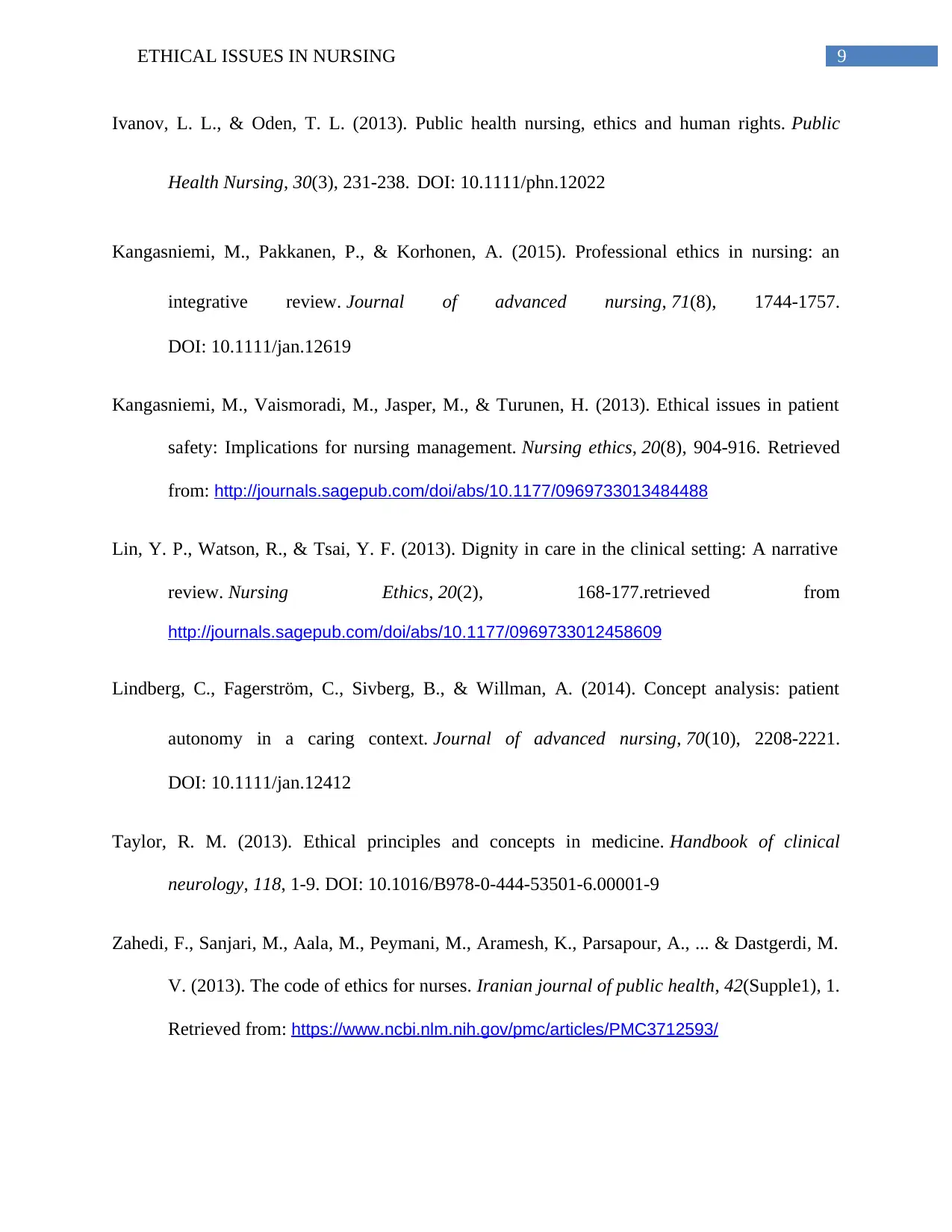
9ETHICAL ISSUES IN NURSING
Ivanov, L. L., & Oden, T. L. (2013). Public health nursing, ethics and human rights. Public
Health Nursing, 30(3), 231-238. DOI: 10.1111/phn.12022
Kangasniemi, M., Pakkanen, P., & Korhonen, A. (2015). Professional ethics in nursing: an
integrative review. Journal of advanced nursing, 71(8), 1744-1757.
DOI: 10.1111/jan.12619
Kangasniemi, M., Vaismoradi, M., Jasper, M., & Turunen, H. (2013). Ethical issues in patient
safety: Implications for nursing management. Nursing ethics, 20(8), 904-916. Retrieved
from: http://journals.sagepub.com/doi/abs/10.1177/0969733013484488
Lin, Y. P., Watson, R., & Tsai, Y. F. (2013). Dignity in care in the clinical setting: A narrative
review. Nursing Ethics, 20(2), 168-177.retrieved from
http://journals.sagepub.com/doi/abs/10.1177/0969733012458609
Lindberg, C., Fagerström, C., Sivberg, B., & Willman, A. (2014). Concept analysis: patient
autonomy in a caring context. Journal of advanced nursing, 70(10), 2208-2221.
DOI: 10.1111/jan.12412
Taylor, R. M. (2013). Ethical principles and concepts in medicine. Handbook of clinical
neurology, 118, 1-9. DOI: 10.1016/B978-0-444-53501-6.00001-9
Zahedi, F., Sanjari, M., Aala, M., Peymani, M., Aramesh, K., Parsapour, A., ... & Dastgerdi, M.
V. (2013). The code of ethics for nurses. Iranian journal of public health, 42(Supple1), 1.
Retrieved from: https://www.ncbi.nlm.nih.gov/pmc/articles/PMC3712593/
Ivanov, L. L., & Oden, T. L. (2013). Public health nursing, ethics and human rights. Public
Health Nursing, 30(3), 231-238. DOI: 10.1111/phn.12022
Kangasniemi, M., Pakkanen, P., & Korhonen, A. (2015). Professional ethics in nursing: an
integrative review. Journal of advanced nursing, 71(8), 1744-1757.
DOI: 10.1111/jan.12619
Kangasniemi, M., Vaismoradi, M., Jasper, M., & Turunen, H. (2013). Ethical issues in patient
safety: Implications for nursing management. Nursing ethics, 20(8), 904-916. Retrieved
from: http://journals.sagepub.com/doi/abs/10.1177/0969733013484488
Lin, Y. P., Watson, R., & Tsai, Y. F. (2013). Dignity in care in the clinical setting: A narrative
review. Nursing Ethics, 20(2), 168-177.retrieved from
http://journals.sagepub.com/doi/abs/10.1177/0969733012458609
Lindberg, C., Fagerström, C., Sivberg, B., & Willman, A. (2014). Concept analysis: patient
autonomy in a caring context. Journal of advanced nursing, 70(10), 2208-2221.
DOI: 10.1111/jan.12412
Taylor, R. M. (2013). Ethical principles and concepts in medicine. Handbook of clinical
neurology, 118, 1-9. DOI: 10.1016/B978-0-444-53501-6.00001-9
Zahedi, F., Sanjari, M., Aala, M., Peymani, M., Aramesh, K., Parsapour, A., ... & Dastgerdi, M.
V. (2013). The code of ethics for nurses. Iranian journal of public health, 42(Supple1), 1.
Retrieved from: https://www.ncbi.nlm.nih.gov/pmc/articles/PMC3712593/
Secure Best Marks with AI Grader
Need help grading? Try our AI Grader for instant feedback on your assignments.

10ETHICAL ISSUES IN NURSING
1 out of 11
Related Documents
Your All-in-One AI-Powered Toolkit for Academic Success.
+13062052269
info@desklib.com
Available 24*7 on WhatsApp / Email
![[object Object]](/_next/static/media/star-bottom.7253800d.svg)
Unlock your academic potential
© 2024 | Zucol Services PVT LTD | All rights reserved.





